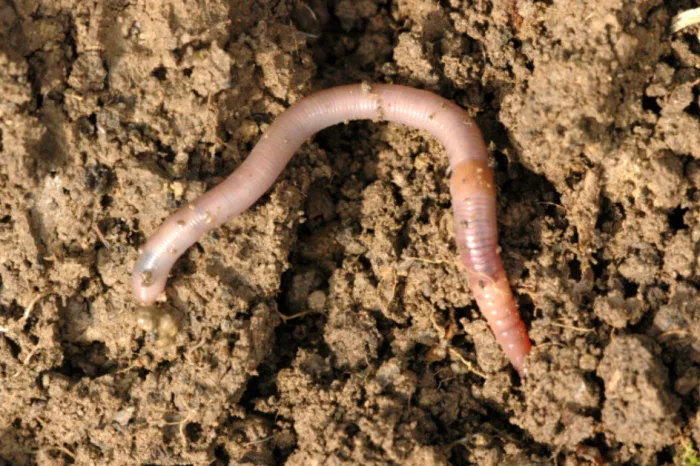
Invasive jumping earthworms: coming to a forest near you?

File photo of an invasive jumping worm. Courtesy: Wikipedia/James Lindsey.
Earthworms are commonly seen as a gardener’s best friend, a sign that your soil is filled with nutrients to keep plants happy and healthy. But outside of garden beds, earthworms aren’t the helpful composters we think they are. In fact, all soil-based earthworms in Ontario are exotic and introduced by humans from other continents. When you imagine a common garden earthworm, you are likely picturing a member of the Lumbricus genera of earthworms, which hail from Europe. Throughout Canada, only a few small locations have native earthworms—the bulk of earthworms in our forests are introduced.
One invasive earthworm species from the genus Amynthas, commonly known as jumping worms, are creeping their way into forests in the Upper Midwest of the United States. Researchers from the University of Illinois at Urbana-Champaign tested soils from hardwood forests that had been invaded by jumping worms for more than a year and discovered changes in the soil’s chemistry and microbial communities. The results suggest that jumping worms can alter the soil of their new homes, which may impact the survival of local plant and wildlife communities.
“There have been no known public-available reports of any of the Amynthas species in Ontario or Canada,” says Colin Cassin, Program and Policy Analyst with the Invasive Species Centre, a not-for-profit based in Sault Ste. Marie, Ontario. But the worms are on Ontario’s doorstep, with reports of the animals coming out of Michigan, New York, Minnesota, and Pennsylvania. It’s also key to note that invasive and exotic earthworms are very much under-reported, says Cassin.
Jumping worms originate from Asian grasslands. At first glance, jumping worms are almost indistinguishable from their European relatives. Once they reach adulthood, jumping worms can be identified by the shape of their reproductive organs, which appear as a centimetre-long cream-coloured band that forms a ring around the top portion of their body. In European earthworms, the band is pink and only partly encircles the body.
LEARN ABOUT ANOTHER INVASIVE SPECIES: MURDER HORNETS
Jumping worms live up to their name: these quick-moving worms shake, thrash, and jump when handled. This behaviour is thought to be a survival tactic to avoid ending up as a predator’s lunch.
If they can’t wiggle their way out of a predator’s grasp, jumping worms have the ability to break off the back part of their tail as an escape mechanism. “Even if a bird were to grab them, they might only get that back part and the worm still survives,” says Gabriel Price-Christenson, Ph.D. candidate at the University of Illinois at Urbana-Champaign and lead author of the new research.
If jumping worms lived by a motto it would be live fast and die young. They generally only live for one year, says Price-Christenson, so to survive the worms have both ‘voracious appetites’ and ‘aggressive reproduction strategies.’
“They have to gain all their mass throughout the year, reproduce as quickly and as much as they can, and then they die off in the first frost,” says Price-Christenson. Compare that to Lumbricus species like nightcrawlers which can live up to 8 years, and it becomes clear why jumping populations can undergo such explosive growth.
As they churn and eat their way through the leaf litter, jumping worms transform the nutrient-rich soil into pellets that Price-Christenson likens to coffee grounds. This transformation has “profound effects on soil structure,” he adds.
When Price-Christenson and his team examined soil samples from soils invaded by jumping worms, they found that plots that been occupied by the worms for more than year had higher nitrogen and different communities of soil bacteria and fungi.
“These forest ecosystems have developed their own cycles for how nitrogen should be cycled through the forest,” says Price-Christenson. “These plant communities have all adapted to very fine amounts of nitrogen.” Changing the chemistry of the forest soil can shift what plants are able to grow and survive, and have cascading effects for wildlife.
Changing soil structures and negatively impacting forests is not unique to jumping worms. Exotic earthworms, both the European and Asian varieties, are well documented to deplete nutrients and reduce litter layers in North American forests.
“Earthworms are good for the garden but bad for the forests,” says Cassin. “In modified settings, like agriculture and gardening, they do a lot of great things for the garden. In natural settings, they’re not helpful.“
Preventing jumping worms from entering Ontario means putting a stopper in the pathways that move all invasive worms. The two main ways exotic earthworms are transported into North America is through being imported as fishing bait and by hitching rides in garden soil and mulch.
Price-Christenson has a simple solution to prevent the spread of jumping worms through angling: Don’t buy them. But because all bait worms can potentially be invasive, Cassin says it is vital that anglers follow proper procedures and dispose of unused worms far from any body of water.
Gardeners should avoid buying mulch from areas that are known to have jumping worm infestations. Once jumping worms are established in the soil, they are very difficult to get rid of, says Price-Christenson. He has heard accounts from gardeners of hundreds of jumping worms spilling out from infested compost bins.
Worms must be euthanized before being placed in the garbage, otherwise you risk spreading the infestation to other areas, including landfills. The most humane way to euthanize worms is with isopropyl alcohol, which kills the worms within seconds, he says. Another method is to place the seal the worms in a ziplock bag and setting the bag in a sunny spot.
For further information on jumping worms and other invasive earthworms, Cassin recommends checking out Great Lake Worm Watch. The University of Minnesota-run site provides identification tips and ways for community scientists to get involved and help track the spread of exotic earthworms.
This article was written for Cottage life by Grace Hunter.









